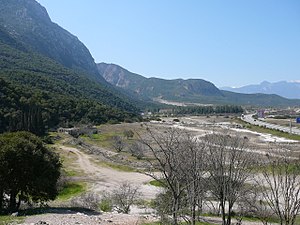
Back ثيرموبيلاي Arabic Termópiles AST ترموپیل AZB Термопили Bulgarian Thermopyloù Breton Termòpiles Catalan Thermopylae (gintang) CEB Thermopyly Czech Thermopylae Welsh Thermopylæ Danish


Thermopylae (/θərˈmɒpɪliː/; Ancient Greek and Katharevousa: Θερμοπύλαι, romanized: Thermopylai; Ancient: [tʰermopýlai], Katharevousa: [θermoˈpile̞]; Demotic Greek (Greek): Θερμοπύλες, romanized: Thermopyles [θermoˈpiles]; "hot gates") is a narrow pass and modern town in Lamia, Phthiotis, Greece. It derives its name from its hot sulphur springs.[1] In Greek mythology the Hot Gates is one of the entrances to Hades.[2]
Thermopylae is the site of the Battle of Thermopylae between the Greek forces (including Spartans, Thebans and Thespians) and the invading Persian forces, commemorated by Simonides of Ceos in the epitaph, "Go tell the Spartans, stranger passing by, That here we lie, having answered our common oaths." Thermopylae is the only land route large enough to bear any significant traffic between Lokris and Thessaly. To go from north to south along the east coast of the Balkans requires use of the pass. In ancient times it was called Malis, named after the Malians (Ancient Greek: Μαλιεῖς), a Greek tribe that lived near present-day Lamia at the delta of the river Spercheios in Greece. The Malian Gulf is also named after them. In the western valley of the Spercheios their land was adjacent to the Aenianes. Their main town was named Trachis. In the town of Anthela, the Malians had an important Temple of Demeter Amphictyonis, an early center of the Anthelan Amphictyony.
The land is dominated by the coastal floodplain of the Spercheios river and is surrounded by sloping forested limestone mountains. There is continuous deposition of sediment from the river and travertine deposits from the hot springs which has substantially altered the landscape during the past few thousand years. The land surface on which the famous Battle of Thermopylae was fought in 480 BC is now buried under 20 metres (66 ft) of soil. The shoreline has also advanced over the centuries because of the sedimentary deposition. The level of the Malian Gulf was also significantly higher during prehistoric times, and the Spercheios River was significantly shorter. Its shoreline advanced by up to 2 kilometers between 2500 BC and 480 BC but has still left several narrow passages between the sea and the mountains. The narrowest point on the plain, where the battle was probably fought, would have been less than 100 metres (330 ft) wide. Between 480 BC and the 21st century, the shoreline advanced by as much as 9 km (5.6 mi) in places, eliminating the narrowest points of the pass and considerably increasing the size of the plain around the outlet of the Spercheios.[3]
The A1 motorway linking Athens and Thessaloniki now follows the ancient shoreline and thus splits the pass; a modern-day monument to King Leonidas I of Sparta is situated on the east side of the highway, directly across the road from the hill where Simonides' epitaph to the fallen is engraved in stone at the top. Thermopylae is part of the "horseshoe of Maliakos", also known as the "horseshoe of death":[citation needed] it is the narrowest part of the highway connecting the north and the south of Greece. It has many turns and has been the site of many vehicular accidents.

The hot springs from which the pass derives its name still exist close to the foot of the hill.

- ^ "Thermopylae" in: S. Hornblower & A. Spawforth (eds.) The Oxford Classical Dictionary, 3rd ed. (Oxford, 1996).
- ^ L.H. Jeffery (1976) Archaic Greece: The City States c. 700–500 BC. Ernest Benn Ltd., London & Tonbridge p. 73. ISBN 0-510-03271-0
- ^ Rapp, George Robert; Hill, Christopher L. Geoarchaeology: The Earth-science Approach to Archaeological Interpretation, p. 96. Yale University Press, 2006. ISBN 0-300-10966-0